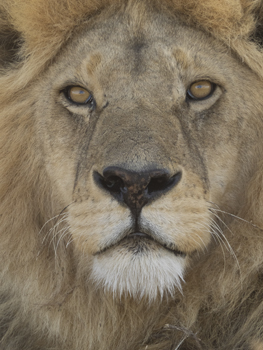
Tanzania Photo Safari
October 2022
Trip Report

A Gray-headed Gull flips its head upside down as
it flies by in the Ngorongoro Crater
Since 2009 we've been traveling to Tanzania's Serengetti National Park, deservedly considered one of the world's premiere wildlife destinations. The area is vast, and when looks across the grasslands to a distant, hazy ridge, its hard to believe that at that ridge, the grasslands would continue on to another mountain or ridge, and from there on and on again. The area is immense, and every mile holds the possibility of exciting wildlife sightings and action.
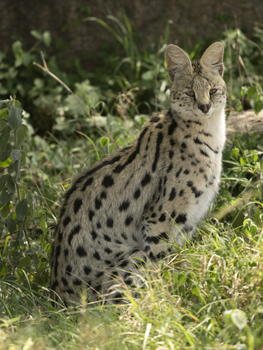
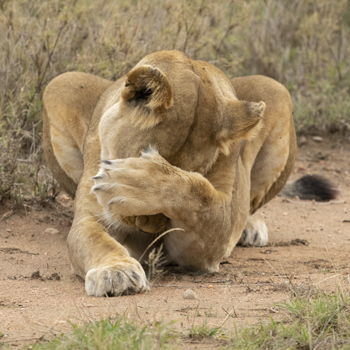
Serval and a shy Lioness
In fall, we concentrate our time at two locations in the Serengetti, as well as Ngorongoro Crater, and as an optional extension, Tarangire National Park. Each one has its own charm and highlights.
In the northern Serengeti we stayed at a camp close to the Mara River, which also snakes its way through Kenya's Masai Mara Game Reserve. Gnus, or wildebeest, usually migrate from Tanzania into the Masai Mara sometime between June and August, grazing there until returning on their migration back into Tanzania between August and December. It is always difficult to precisely predict when the migration will occur, and whether or not Gnus will even move as far north as the Mara and if they do, when they'll turn around and head back into Tanzania.
.jpg)
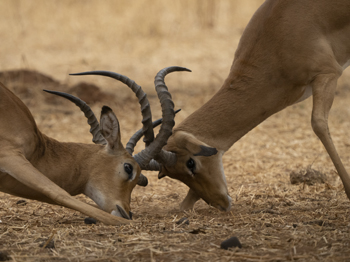
Hartebeest, Impala males in a semi-serious contest
This year we were extremely lucky, for the Gnu herds were still in the southern portion of the Mara and herds of varying size crossed the Mara River. When we'd hear that the wildebeest were gathering we'd head to the river where we'd wait for a crossing to begin.
In contrast to Peak Season in Kenya's Masai Mara where over 100 vehicles may gather and crowd a Gnu crossing, Tanzania's tourist pressure is less -- well, at least it is in October! Our first good crossing required a wait for several hours as the Gnus headed towards a shoreline, a crossing imminent, then changing their mind and trotting down or up river towards another crossing point, or simply turning around and returning to the plains. After several false starts, the Gnus crossed, and the wait was worth it.
On another morning, Mary's vehicle paused to check the river before continuing on the game drive. I didn't, thinking that after the previous day's crossing the plains would be empty, or that gnus wouldn't be ready to cross. I was wrong, as Mary's guide spotted a huge herd lined up at the river. I got the radio call and raced to join Mary, who had arrived to find that the herd, thousands of animals, had already crossed! Or so she thought, until she arrived at the river and found that thousands more were lined up and crashing into the river. For fifteen minutes Mary's vehicle was the only one there, until I joined her and another vehicle arrived. That crossing was spectacular, and lasted long enough for several thousand gnus to cross.
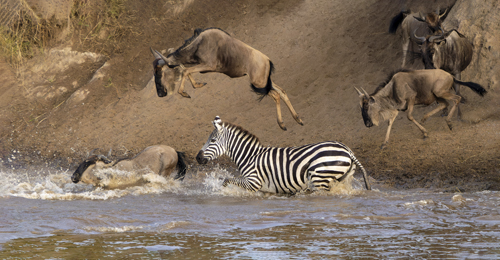
Photographers travel to the Mara in the hope that they'll see a Gnu river crossing, but that is never guaranteed. The river isn't a boundary that separates the Mara from the Serengetti, as Gnus can move into the Mara from the southeast and return to Tanzania by simply reversing their route, and never even see the Mara! Herds may gather at or near the river for days and never cross, so our group was lucky, and had that great luck without alot of painful waiting.
Our focus was on more than just Gnus, especially so since one never knows if even a single herd is still in the northern end of their migration. Although we had great luck wiht a variety of birds and wildlife in the northern section, our shooting was even more diverse and potentially more rewarding when we traveled to our second base camp in the Serengeti. Here we did well with a small Lion pride with young cubs, and a great male Lion that gave us a bit more insight into the senses of these cats.
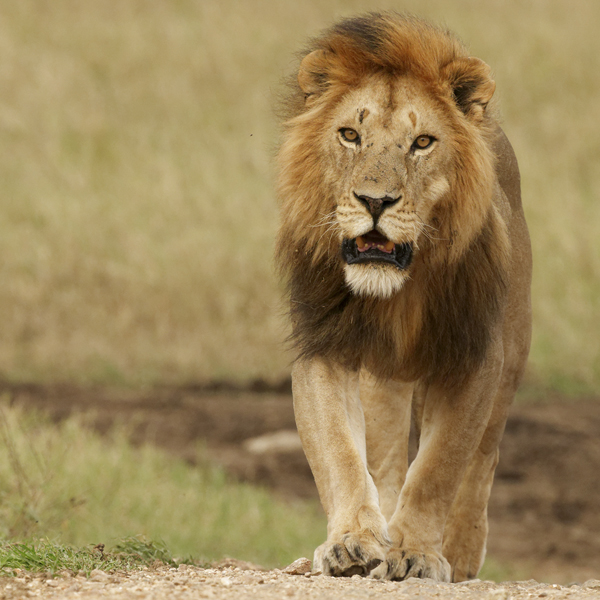
Mary's vehicle had spotted a male Lion and as we headed in that direction we encountered a Lioness lying beside the track. While we photographed her she gave a few low vocalizations that we could barely hear, just thirty or so yards away. Apparently, and I'm guessing here, her call was quite subsonic and at a low frequency, and although 100 yards away we wouldn't hear anything, the male Lion, an easy 1/2 mile or further away, heard the Lioness and moved towards her.
He was intent, which was evident as his eyes were often wide open, staring intently forward, as he advanced. Lions that are merely meandering, perhaps heading for shade or water, often blink or close their eyes, a quite different look than this one. When the Lion finally reached the Lioness, she urinated and trotted off. The male, who never got close, sniffed the urine and did a flehmen response, sniffing the urine and making a face that looked like a snarl.
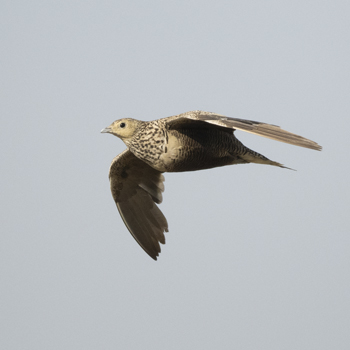

Chestnut-bellied Sandgrouse; Klipspringer
Other highlights included several great sessions with the small Klipspringer antelope. This specis inhabits cliffs and rock faces, negoiating these steep and often slick surfaces by a unique adaptation. Klipsprings seem to stand upon their tip-toes, standing on the tip of their hooves rather than somewhat flat-footed as other antelope stand. Surprisingly, although we're only a few miles from Kenya's Masai Mara, I haven't seen a Klipspringer here, but on the Tanzania side, in some of the most picturesque kopjes in the Serengetti, they are common.
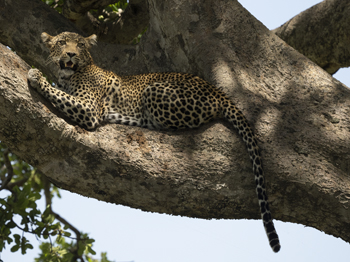
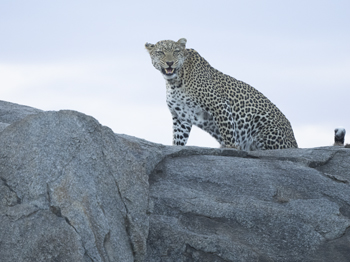
Leopard in the north, in a tree, and in the central, on a kopje
We did quite well with Leopards, at both our Serengetti destinations. In the north, we had the classic 'leopard in a tree' shot, and in the central section we had several Leopards in the kopjes. We set a record for Servals, the small, bobcat-sized spotted cat of the grasslands, seeing 11 Servals during the main trip, in both the Serengetti and at Ngorongoro Crater.

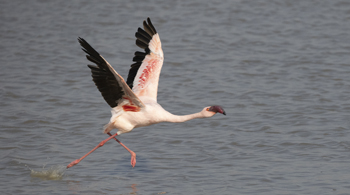
Zebras dustbathing; Lesser Flamingo taking flight
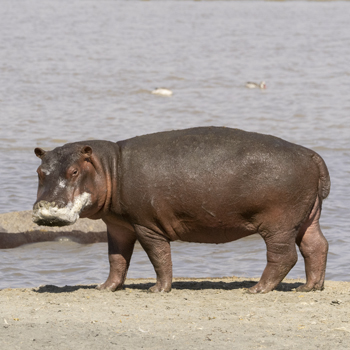
.jpg)
Hippo after drinking milk?, Egyptian Geese in a spat
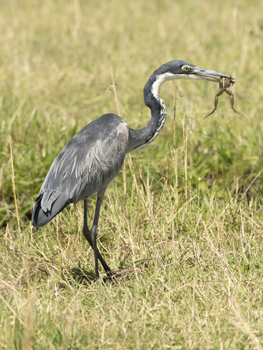
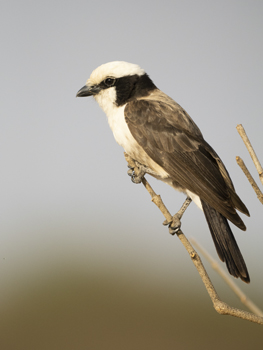
Black-headed Heron with a frog, White-crowned Shrike
The crater, a collasped volcanic caldera after the mountain top blasted into dust and ash millions of years ago, has a permanent population of almost all of the Serengetti mammals. In different years the rainfall varies, and a few years ago many of the Crater's roads were closed, due to high water. This year the water level was perfect, as there was plenty of water but all of the roads were open.
One of our favorite locations in the Crater was at the end of a game track overlooking a large bay. Greater and Lesser Flamingos, various shorebirds, herons, and pelicans, and a large herd of Hippos fed or swam or played here - the highlight of the Crater.
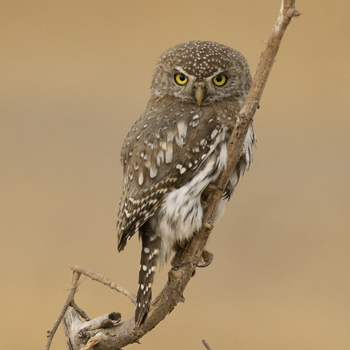
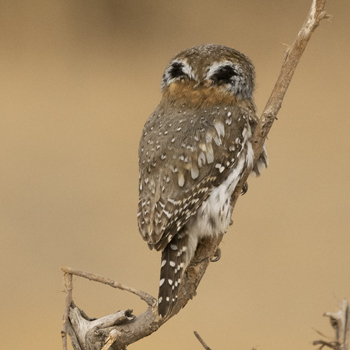
Pearl-spotted Owlet - several species of small owls, including the Pigmy Owls here in the US, have false eyespots on the back of their head. These fake eyes may deter a potential predator from attacking, and small birds (who seem to 'hate' owls) from dive-bombing and harassing the owl as they may think the owl is looking at them. We saw a surprising number of Owlets in Tarangire - a real treat.
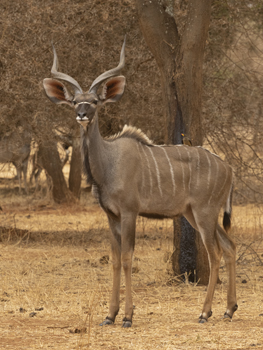

Greater Kudu and Lesser Kudu in Tarangire
Our last location was an optional extension to Tarangire National Park, a picturesque location we haven't visited in several years. The park is famous for its unique and beautiful Baobob trees and its large herd of Elephants, but we found the bird life particularly rewarding. There were Shrikes of various species everywhere, but the bird life, in general, was extremely diverse and presented multiple opportunities for photography. The park was so good that we'll be adding this as an extension to all our future trips. If you like birds, or bird photography, you'll love Tarangire!

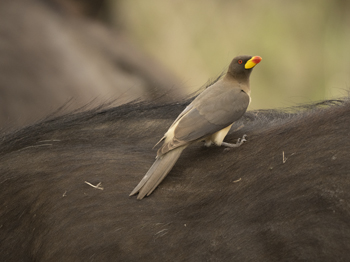
Long-crested Eagle; Yellow-billed Oxpecker
We'll be returning to Tanzania in the fall of 2024. It's not too late to start planning, so contact our office and get on the list!
Facebook
Flickr
Instagram
YouTube Channel
Join us on Facebook at: Follow Hoot Hollow
Office Phone: (717) 543-6423
Email us at info@hoothollow.com
test

Tanzania Photo Safari
October 2022
Trip Report

A Gray-headed Gull flips its head upside down as
it flies by in the Ngorongoro Crater
Since 2009 we've been traveling to Tanzania's Serengetti National Park, deservedly considered one of the world's premiere wildlife destinations. The area is vast, and when looks across the grasslands to a distant, hazy ridge, its hard to believe that at that ridge, the grasslands would continue on to another mountain or ridge, and from there on and on again. The area is immense, and every mile holds the possibility of exciting wildlife sightings and action.


Serval and a shy Lioness
In fall, we concentrate our time at two locations in the Serengetti, as well as Ngorongoro Crater, and as an optional extension, Tarangire National Park. Each one has its own charm and highlights.
In the northern Serengeti we stayed at a camp close to the Mara River, which also snakes its way through Kenya's Masai Mara Game Reserve. Gnus, or wildebeest, usually migrate from Tanzania into the Masai Mara sometime between June and August, grazing there until returning on their migration back into Tanzania between August and December. It is always difficult to precisely predict when the migration will occur, and whether or not Gnus will even move as far north as the Mara and if they do, when they'll turn around and head back into Tanzania.
.jpg)

Hartebeest, Impala males in a semi-serious contest
This year we were extremely lucky, for the Gnu herds were still in the southern portion of the Mara and herds of varying size crossed the Mara River. When we'd hear that the wildebeest were gathering we'd head to the river where we'd wait for a crossing to begin.
In contrast to Peak Season in Kenya's Masai Mara where over 100 vehicles may gather and crowd a Gnu crossing, Tanzania's tourist pressure is less -- well, at least it is in October! Our first good crossing required a wait for several hours as the Gnus headed towards a shoreline, a crossing imminent, then changing their mind and trotting down or up river towards another crossing point, or simply turning around and returning to the plains. After several false starts, the Gnus crossed, and the wait was worth it.
On another morning, Mary's vehicle paused to check the river before continuing on the game drive. I didn't, thinking that after the previous day's crossing the plains would be empty, or that gnus wouldn't be ready to cross. I was wrong, as Mary's guide spotted a huge herd lined up at the river. I got the radio call and raced to join Mary, who had arrived to find that the herd, thousands of animals, had already crossed! Or so she thought, until she arrived at the river and found that thousands more were lined up and crashing into the river. For fifteen minutes Mary's vehicle was the only one there, until I joined her and another vehicle arrived. That crossing was spectacular, and lasted long enough for several thousand gnus to cross.

Photographers travel to the Mara in the hope that they'll see a Gnu river crossing, but that is never guaranteed. The river isn't a boundary that separates the Mara from the Serengetti, as Gnus can move into the Mara from the southeast and return to Tanzania by simply reversing their route, and never even see the Mara! Herds may gather at or near the river for days and never cross, so our group was lucky, and had that great luck without alot of painful waiting.
Our focus was on more than just Gnus, especially so since one never knows if even a single herd is still in the northern end of their migration. Although we had great luck wiht a variety of birds and wildlife in the northern section, our shooting was even more diverse and potentially more rewarding when we traveled to our second base camp in the Serengeti. Here we did well with a small Lion pride with young cubs, and a great male Lion that gave us a bit more insight into the senses of these cats.

Mary's vehicle had spotted a male Lion and as we headed in that direction we encountered a Lioness lying beside the track. While we photographed her she gave a few low vocalizations that we could barely hear, just thirty or so yards away. Apparently, and I'm guessing here, her call was quite subsonic and at a low frequency, and although 100 yards away we wouldn't hear anything, the male Lion, an easy 1/2 mile or further away, heard the Lioness and moved towards her.
He was intent, which was evident as his eyes were often wide open, staring intently forward, as he advanced. Lions that are merely meandering, perhaps heading for shade or water, often blink or close their eyes, a quite different look than this one. When the Lion finally reached the Lioness, she urinated and trotted off. The male, who never got close, sniffed the urine and did a flehmen response, sniffing the urine and making a face that looked like a snarl.


Chestnut-bellied Sandgrouse; Klipspringer
Other highlights included several great sessions with the small Klipspringer antelope. This specis inhabits cliffs and rock faces, negoiating these steep and often slick surfaces by a unique adaptation. Klipsprings seem to stand upon their tip-toes, standing on the tip of their hooves rather than somewhat flat-footed as other antelope stand. Surprisingly, although we're only a few miles from Kenya's Masai Mara, I haven't seen a Klipspringer here, but on the Tanzania side, in some of the most picturesque kopjes in the Serengetti, they are common.


Leopard in the north, in a tree, and in the central, on a kopje
We did quite well with Leopards, at both our Serengetti destinations. In the north, we had the classic 'leopard in a tree' shot, and in the central section we had several Leopards in the kopjes. We set a record for Servals, the small, bobcat-sized spotted cat of the grasslands, seeing 11 Servals during the main trip, in both the Serengetti and at Ngorongoro Crater.


Zebras dustbathing; Lesser Flamingo taking flight

.jpg)
Hippo after drinking milk?, Egyptian Geese in a spat


Black-headed Heron with a frog, White-crowned Shrike
The crater, a collasped volcanic caldera after the mountain top blasted into dust and ash millions of years ago, has a permanent population of almost all of the Serengetti mammals. In different years the rainfall varies, and a few years ago many of the Crater's roads were closed, due to high water. This year the water level was perfect, as there was plenty of water but all of the roads were open.
One of our favorite locations in the Crater was at the end of a game track overlooking a large bay. Greater and Lesser Flamingos, various shorebirds, herons, and pelicans, and a large herd of Hippos fed or swam or played here - the highlight of the Crater.


Pearl-spotted Owlet - several species of small owls, including the Pigmy Owls here in the US, have false eyespots on the back of their head. These fake eyes may deter a potential predator from attacking, and small birds (who seem to 'hate' owls) from dive-bombing and harassing the owl as they may think the owl is looking at them. We saw a surprising number of Owlets in Tarangire - a real treat.


Greater Kudu and Lesser Kudu in Tarangire
Our last location was an optional extension to Tarangire National Park, a picturesque location we haven't visited in several years. The park is famous for its unique and beautiful Baobob trees and its large herd of Elephants, but we found the bird life particularly rewarding. There were Shrikes of various species everywhere, but the bird life, in general, was extremely diverse and presented multiple opportunities for photography. The park was so good that we'll be adding this as an extension to all our future trips. If you like birds, or bird photography, you'll love Tarangire!


Long-crested Eagle; Yellow-billed Oxpecker
We'll be returning to Tanzania in the fall of 2024. It's not too late to start planning, so contact our office and get on the list!
Facebook
Flickr
Instagram
YouTube Channel
Join us on Facebook at: Follow Hoot Hollow
Office Phone: (717) 543-6423
Email us at info@hoothollow.com
test

Tanzania Photo Safari
October 2022
Trip Report

A Gray-headed Gull flips its head upside down as
it flies by in the Ngorongoro Crater
Since 2009 we've been traveling to Tanzania's Serengetti National Park, deservedly considered one of the world's premiere wildlife destinations. The area is vast, and when looks across the grasslands to a distant, hazy ridge, its hard to believe that at that ridge, the grasslands would continue on to another mountain or ridge, and from there on and on again. The area is immense, and every mile holds the possibility of exciting wildlife sightings and action.


Serval and a shy Lioness
In fall, we concentrate our time at two locations in the Serengetti, as well as Ngorongoro Crater, and as an optional extension, Tarangire National Park. Each one has its own charm and highlights.
In the northern Serengeti we stayed at a camp close to the Mara River, which also snakes its way through Kenya's Masai Mara Game Reserve. Gnus, or wildebeest, usually migrate from Tanzania into the Masai Mara sometime between June and August, grazing there until returning on their migration back into Tanzania between August and December. It is always difficult to precisely predict when the migration will occur, and whether or not Gnus will even move as far north as the Mara and if they do, when they'll turn around and head back into Tanzania.
.jpg)

Hartebeest, Impala males in a semi-serious contest
This year we were extremely lucky, for the Gnu herds were still in the southern portion of the Mara and herds of varying size crossed the Mara River. When we'd hear that the wildebeest were gathering we'd head to the river where we'd wait for a crossing to begin.
In contrast to Peak Season in Kenya's Masai Mara where over 100 vehicles may gather and crowd a Gnu crossing, Tanzania's tourist pressure is less -- well, at least it is in October! Our first good crossing required a wait for several hours as the Gnus headed towards a shoreline, a crossing imminent, then changing their mind and trotting down or up river towards another crossing point, or simply turning around and returning to the plains. After several false starts, the Gnus crossed, and the wait was worth it.
On another morning, Mary's vehicle paused to check the river before continuing on the game drive. I didn't, thinking that after the previous day's crossing the plains would be empty, or that gnus wouldn't be ready to cross. I was wrong, as Mary's guide spotted a huge herd lined up at the river. I got the radio call and raced to join Mary, who had arrived to find that the herd, thousands of animals, had already crossed! Or so she thought, until she arrived at the river and found that thousands more were lined up and crashing into the river. For fifteen minutes Mary's vehicle was the only one there, until I joined her and another vehicle arrived. That crossing was spectacular, and lasted long enough for several thousand gnus to cross.

Photographers travel to the Mara in the hope that they'll see a Gnu river crossing, but that is never guaranteed. The river isn't a boundary that separates the Mara from the Serengetti, as Gnus can move into the Mara from the southeast and return to Tanzania by simply reversing their route, and never even see the Mara! Herds may gather at or near the river for days and never cross, so our group was lucky, and had that great luck without alot of painful waiting.
Our focus was on more than just Gnus, especially so since one never knows if even a single herd is still in the northern end of their migration. Although we had great luck wiht a variety of birds and wildlife in the northern section, our shooting was even more diverse and potentially more rewarding when we traveled to our second base camp in the Serengeti. Here we did well with a small Lion pride with young cubs, and a great male Lion that gave us a bit more insight into the senses of these cats.

Mary's vehicle had spotted a male Lion and as we headed in that direction we encountered a Lioness lying beside the track. While we photographed her she gave a few low vocalizations that we could barely hear, just thirty or so yards away. Apparently, and I'm guessing here, her call was quite subsonic and at a low frequency, and although 100 yards away we wouldn't hear anything, the male Lion, an easy 1/2 mile or further away, heard the Lioness and moved towards her.
He was intent, which was evident as his eyes were often wide open, staring intently forward, as he advanced. Lions that are merely meandering, perhaps heading for shade or water, often blink or close their eyes, a quite different look than this one. When the Lion finally reached the Lioness, she urinated and trotted off. The male, who never got close, sniffed the urine and did a flehmen response, sniffing the urine and making a face that looked like a snarl.


Chestnut-bellied Sandgrouse; Klipspringer
Other highlights included several great sessions with the small Klipspringer antelope. This specis inhabits cliffs and rock faces, negoiating these steep and often slick surfaces by a unique adaptation. Klipsprings seem to stand upon their tip-toes, standing on the tip of their hooves rather than somewhat flat-footed as other antelope stand. Surprisingly, although we're only a few miles from Kenya's Masai Mara, I haven't seen a Klipspringer here, but on the Tanzania side, in some of the most picturesque kopjes in the Serengetti, they are common.


Leopard in the north, in a tree, and in the central, on a kopje
We did quite well with Leopards, at both our Serengetti destinations. In the north, we had the classic 'leopard in a tree' shot, and in the central section we had several Leopards in the kopjes. We set a record for Servals, the small, bobcat-sized spotted cat of the grasslands, seeing 11 Servals during the main trip, in both the Serengetti and at Ngorongoro Crater.


Zebras dustbathing; Lesser Flamingo taking flight

.jpg)
Hippo after drinking milk?, Egyptian Geese in a spat


Black-headed Heron with a frog, White-crowned Shrike
The crater, a collasped volcanic caldera after the mountain top blasted into dust and ash millions of years ago, has a permanent population of almost all of the Serengetti mammals. In different years the rainfall varies, and a few years ago many of the Crater's roads were closed, due to high water. This year the water level was perfect, as there was plenty of water but all of the roads were open.
One of our favorite locations in the Crater was at the end of a game track overlooking a large bay. Greater and Lesser Flamingos, various shorebirds, herons, and pelicans, and a large herd of Hippos fed or swam or played here - the highlight of the Crater.


Pearl-spotted Owlet - several species of small owls, including the Pigmy Owls here in the US, have false eyespots on the back of their head. These fake eyes may deter a potential predator from attacking, and small birds (who seem to 'hate' owls) from dive-bombing and harassing the owl as they may think the owl is looking at them. We saw a surprising number of Owlets in Tarangire - a real treat.


Greater Kudu and Lesser Kudu in Tarangire
Our last location was an optional extension to Tarangire National Park, a picturesque location we haven't visited in several years. The park is famous for its unique and beautiful Baobob trees and its large herd of Elephants, but we found the bird life particularly rewarding. There were Shrikes of various species everywhere, but the bird life, in general, was extremely diverse and presented multiple opportunities for photography. The park was so good that we'll be adding this as an extension to all our future trips. If you like birds, or bird photography, you'll love Tarangire!


Long-crested Eagle; Yellow-billed Oxpecker
We'll be returning to Tanzania in the fall of 2024. It's not too late to start planning, so contact our office and get on the list!
Facebook
Flickr
Instagram
YouTube Channel
Join us on Facebook at: Follow Hoot Hollow
Office Phone: (717) 543-6423
Email us at info@hoothollow.com
test

Tanzania Photo Safari
October 2022
Trip Report

A Gray-headed Gull flips its head upside down as
it flies by in the Ngorongoro Crater
Since 2009 we've been traveling to Tanzania's Serengetti National Park, deservedly considered one of the world's premiere wildlife destinations. The area is vast, and when looks across the grasslands to a distant, hazy ridge, its hard to believe that at that ridge, the grasslands would continue on to another mountain or ridge, and from there on and on again. The area is immense, and every mile holds the possibility of exciting wildlife sightings and action.


Serval and a shy Lioness
In fall, we concentrate our time at two locations in the Serengetti, as well as Ngorongoro Crater, and as an optional extension, Tarangire National Park. Each one has its own charm and highlights.
In the northern Serengeti we stayed at a camp close to the Mara River, which also snakes its way through Kenya's Masai Mara Game Reserve. Gnus, or wildebeest, usually migrate from Tanzania into the Masai Mara sometime between June and August, grazing there until returning on their migration back into Tanzania between August and December. It is always difficult to precisely predict when the migration will occur, and whether or not Gnus will even move as far north as the Mara and if they do, when they'll turn around and head back into Tanzania.
.jpg)

Hartebeest, Impala males in a semi-serious contest
This year we were extremely lucky, for the Gnu herds were still in the southern portion of the Mara and herds of varying size crossed the Mara River. When we'd hear that the wildebeest were gathering we'd head to the river where we'd wait for a crossing to begin.
In contrast to Peak Season in Kenya's Masai Mara where over 100 vehicles may gather and crowd a Gnu crossing, Tanzania's tourist pressure is less -- well, at least it is in October! Our first good crossing required a wait for several hours as the Gnus headed towards a shoreline, a crossing imminent, then changing their mind and trotting down or up river towards another crossing point, or simply turning around and returning to the plains. After several false starts, the Gnus crossed, and the wait was worth it.
On another morning, Mary's vehicle paused to check the river before continuing on the game drive. I didn't, thinking that after the previous day's crossing the plains would be empty, or that gnus wouldn't be ready to cross. I was wrong, as Mary's guide spotted a huge herd lined up at the river. I got the radio call and raced to join Mary, who had arrived to find that the herd, thousands of animals, had already crossed! Or so she thought, until she arrived at the river and found that thousands more were lined up and crashing into the river. For fifteen minutes Mary's vehicle was the only one there, until I joined her and another vehicle arrived. That crossing was spectacular, and lasted long enough for several thousand gnus to cross.

Photographers travel to the Mara in the hope that they'll see a Gnu river crossing, but that is never guaranteed. The river isn't a boundary that separates the Mara from the Serengetti, as Gnus can move into the Mara from the southeast and return to Tanzania by simply reversing their route, and never even see the Mara! Herds may gather at or near the river for days and never cross, so our group was lucky, and had that great luck without alot of painful waiting.
Our focus was on more than just Gnus, especially so since one never knows if even a single herd is still in the northern end of their migration. Although we had great luck wiht a variety of birds and wildlife in the northern section, our shooting was even more diverse and potentially more rewarding when we traveled to our second base camp in the Serengeti. Here we did well with a small Lion pride with young cubs, and a great male Lion that gave us a bit more insight into the senses of these cats.

Mary's vehicle had spotted a male Lion and as we headed in that direction we encountered a Lioness lying beside the track. While we photographed her she gave a few low vocalizations that we could barely hear, just thirty or so yards away. Apparently, and I'm guessing here, her call was quite subsonic and at a low frequency, and although 100 yards away we wouldn't hear anything, the male Lion, an easy 1/2 mile or further away, heard the Lioness and moved towards her.
He was intent, which was evident as his eyes were often wide open, staring intently forward, as he advanced. Lions that are merely meandering, perhaps heading for shade or water, often blink or close their eyes, a quite different look than this one. When the Lion finally reached the Lioness, she urinated and trotted off. The male, who never got close, sniffed the urine and did a flehmen response, sniffing the urine and making a face that looked like a snarl.


Chestnut-bellied Sandgrouse; Klipspringer
Other highlights included several great sessions with the small Klipspringer antelope. This specis inhabits cliffs and rock faces, negoiating these steep and often slick surfaces by a unique adaptation. Klipsprings seem to stand upon their tip-toes, standing on the tip of their hooves rather than somewhat flat-footed as other antelope stand. Surprisingly, although we're only a few miles from Kenya's Masai Mara, I haven't seen a Klipspringer here, but on the Tanzania side, in some of the most picturesque kopjes in the Serengetti, they are common.


Leopard in the north, in a tree, and in the central, on a kopje
We did quite well with Leopards, at both our Serengetti destinations. In the north, we had the classic 'leopard in a tree' shot, and in the central section we had several Leopards in the kopjes. We set a record for Servals, the small, bobcat-sized spotted cat of the grasslands, seeing 11 Servals during the main trip, in both the Serengetti and at Ngorongoro Crater.


Zebras dustbathing; Lesser Flamingo taking flight

.jpg)
Hippo after drinking milk?, Egyptian Geese in a spat


Black-headed Heron with a frog, White-crowned Shrike
The crater, a collasped volcanic caldera after the mountain top blasted into dust and ash millions of years ago, has a permanent population of almost all of the Serengetti mammals. In different years the rainfall varies, and a few years ago many of the Crater's roads were closed, due to high water. This year the water level was perfect, as there was plenty of water but all of the roads were open.
One of our favorite locations in the Crater was at the end of a game track overlooking a large bay. Greater and Lesser Flamingos, various shorebirds, herons, and pelicans, and a large herd of Hippos fed or swam or played here - the highlight of the Crater.


Pearl-spotted Owlet - several species of small owls, including the Pigmy Owls here in the US, have false eyespots on the back of their head. These fake eyes may deter a potential predator from attacking, and small birds (who seem to 'hate' owls) from dive-bombing and harassing the owl as they may think the owl is looking at them. We saw a surprising number of Owlets in Tarangire - a real treat.


Greater Kudu and Lesser Kudu in Tarangire
Our last location was an optional extension to Tarangire National Park, a picturesque location we haven't visited in several years. The park is famous for its unique and beautiful Baobob trees and its large herd of Elephants, but we found the bird life particularly rewarding. There were Shrikes of various species everywhere, but the bird life, in general, was extremely diverse and presented multiple opportunities for photography. The park was so good that we'll be adding this as an extension to all our future trips. If you like birds, or bird photography, you'll love Tarangire!


Long-crested Eagle; Yellow-billed Oxpecker
We'll be returning to Tanzania in the fall of 2024. It's not too late to start planning, so contact our office and get on the list!
Facebook
Flickr
Instagram
YouTube Channel
Join us on Facebook at: Follow Hoot Hollow
Office Phone: (717) 543-6423
Email us at info@hoothollow.com
test

Tanzania Photo Safari
October 2022
Trip Report

A Gray-headed Gull flips its head upside down as
it flies by in the Ngorongoro Crater
Since 2009 we've been traveling to Tanzania's Serengetti National Park, deservedly considered one of the world's premiere wildlife destinations. The area is vast, and when looks across the grasslands to a distant, hazy ridge, its hard to believe that at that ridge, the grasslands would continue on to another mountain or ridge, and from there on and on again. The area is immense, and every mile holds the possibility of exciting wildlife sightings and action.


Serval and a shy Lioness
In fall, we concentrate our time at two locations in the Serengetti, as well as Ngorongoro Crater, and as an optional extension, Tarangire National Park. Each one has its own charm and highlights.
In the northern Serengeti we stayed at a camp close to the Mara River, which also snakes its way through Kenya's Masai Mara Game Reserve. Gnus, or wildebeest, usually migrate from Tanzania into the Masai Mara sometime between June and August, grazing there until returning on their migration back into Tanzania between August and December. It is always difficult to precisely predict when the migration will occur, and whether or not Gnus will even move as far north as the Mara and if they do, when they'll turn around and head back into Tanzania.
.jpg)

Hartebeest, Impala males in a semi-serious contest
This year we were extremely lucky, for the Gnu herds were still in the southern portion of the Mara and herds of varying size crossed the Mara River. When we'd hear that the wildebeest were gathering we'd head to the river where we'd wait for a crossing to begin.
In contrast to Peak Season in Kenya's Masai Mara where over 100 vehicles may gather and crowd a Gnu crossing, Tanzania's tourist pressure is less -- well, at least it is in October! Our first good crossing required a wait for several hours as the Gnus headed towards a shoreline, a crossing imminent, then changing their mind and trotting down or up river towards another crossing point, or simply turning around and returning to the plains. After several false starts, the Gnus crossed, and the wait was worth it.
On another morning, Mary's vehicle paused to check the river before continuing on the game drive. I didn't, thinking that after the previous day's crossing the plains would be empty, or that gnus wouldn't be ready to cross. I was wrong, as Mary's guide spotted a huge herd lined up at the river. I got the radio call and raced to join Mary, who had arrived to find that the herd, thousands of animals, had already crossed! Or so she thought, until she arrived at the river and found that thousands more were lined up and crashing into the river. For fifteen minutes Mary's vehicle was the only one there, until I joined her and another vehicle arrived. That crossing was spectacular, and lasted long enough for several thousand gnus to cross.

Photographers travel to the Mara in the hope that they'll see a Gnu river crossing, but that is never guaranteed. The river isn't a boundary that separates the Mara from the Serengetti, as Gnus can move into the Mara from the southeast and return to Tanzania by simply reversing their route, and never even see the Mara! Herds may gather at or near the river for days and never cross, so our group was lucky, and had that great luck without alot of painful waiting.
Our focus was on more than just Gnus, especially so since one never knows if even a single herd is still in the northern end of their migration. Although we had great luck wiht a variety of birds and wildlife in the northern section, our shooting was even more diverse and potentially more rewarding when we traveled to our second base camp in the Serengeti. Here we did well with a small Lion pride with young cubs, and a great male Lion that gave us a bit more insight into the senses of these cats.

Mary's vehicle had spotted a male Lion and as we headed in that direction we encountered a Lioness lying beside the track. While we photographed her she gave a few low vocalizations that we could barely hear, just thirty or so yards away. Apparently, and I'm guessing here, her call was quite subsonic and at a low frequency, and although 100 yards away we wouldn't hear anything, the male Lion, an easy 1/2 mile or further away, heard the Lioness and moved towards her.
He was intent, which was evident as his eyes were often wide open, staring intently forward, as he advanced. Lions that are merely meandering, perhaps heading for shade or water, often blink or close their eyes, a quite different look than this one. When the Lion finally reached the Lioness, she urinated and trotted off. The male, who never got close, sniffed the urine and did a flehmen response, sniffing the urine and making a face that looked like a snarl.


Chestnut-bellied Sandgrouse; Klipspringer
Other highlights included several great sessions with the small Klipspringer antelope. This specis inhabits cliffs and rock faces, negoiating these steep and often slick surfaces by a unique adaptation. Klipsprings seem to stand upon their tip-toes, standing on the tip of their hooves rather than somewhat flat-footed as other antelope stand. Surprisingly, although we're only a few miles from Kenya's Masai Mara, I haven't seen a Klipspringer here, but on the Tanzania side, in some of the most picturesque kopjes in the Serengetti, they are common.


Leopard in the north, in a tree, and in the central, on a kopje
We did quite well with Leopards, at both our Serengetti destinations. In the north, we had the classic 'leopard in a tree' shot, and in the central section we had several Leopards in the kopjes. We set a record for Servals, the small, bobcat-sized spotted cat of the grasslands, seeing 11 Servals during the main trip, in both the Serengetti and at Ngorongoro Crater.


Zebras dustbathing; Lesser Flamingo taking flight

.jpg)
Hippo after drinking milk?, Egyptian Geese in a spat


Black-headed Heron with a frog, White-crowned Shrike
The crater, a collasped volcanic caldera after the mountain top blasted into dust and ash millions of years ago, has a permanent population of almost all of the Serengetti mammals. In different years the rainfall varies, and a few years ago many of the Crater's roads were closed, due to high water. This year the water level was perfect, as there was plenty of water but all of the roads were open.
One of our favorite locations in the Crater was at the end of a game track overlooking a large bay. Greater and Lesser Flamingos, various shorebirds, herons, and pelicans, and a large herd of Hippos fed or swam or played here - the highlight of the Crater.


Pearl-spotted Owlet - several species of small owls, including the Pigmy Owls here in the US, have false eyespots on the back of their head. These fake eyes may deter a potential predator from attacking, and small birds (who seem to 'hate' owls) from dive-bombing and harassing the owl as they may think the owl is looking at them. We saw a surprising number of Owlets in Tarangire - a real treat.


Greater Kudu and Lesser Kudu in Tarangire
Our last location was an optional extension to Tarangire National Park, a picturesque location we haven't visited in several years. The park is famous for its unique and beautiful Baobob trees and its large herd of Elephants, but we found the bird life particularly rewarding. There were Shrikes of various species everywhere, but the bird life, in general, was extremely diverse and presented multiple opportunities for photography. The park was so good that we'll be adding this as an extension to all our future trips. If you like birds, or bird photography, you'll love Tarangire!


Long-crested Eagle; Yellow-billed Oxpecker
We'll be returning to Tanzania in the fall of 2024. It's not too late to start planning, so contact our office and get on the list!
Facebook
Flickr
Instagram
YouTube Channel
Join us on Facebook at: Follow Hoot Hollow
Office Phone: (717) 543-6423
Email us at info@hoothollow.com
Join us on Facebook at: Follow Hoot Hollow
Office Phone: (717) 543-6423
Email us at info@hoothollow.com
test


